Last Updated on April 15, 2025 by Owen McGab Enaohwo
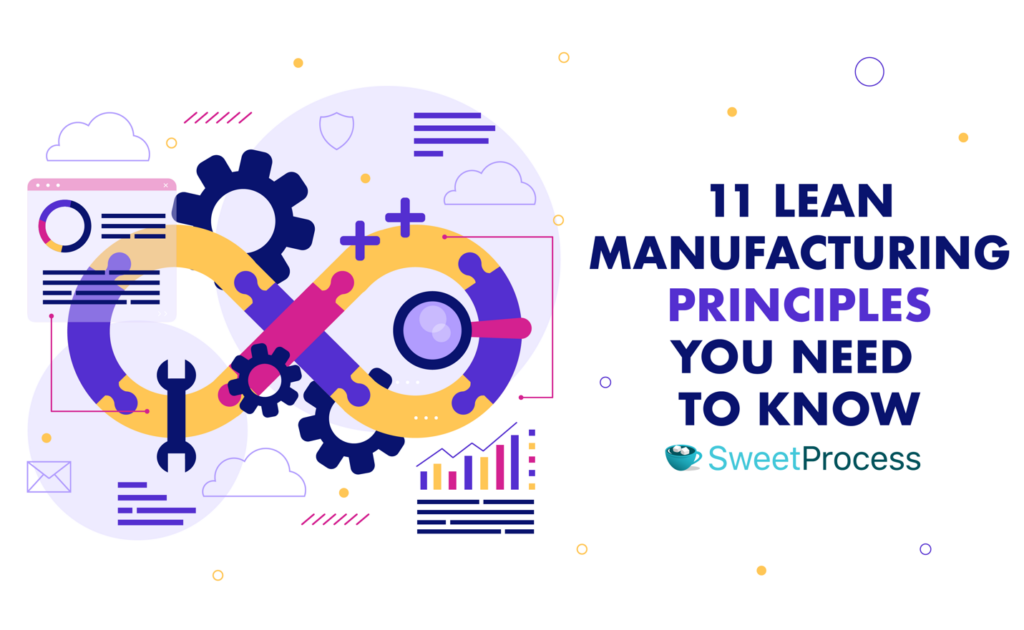
Are you currently looking into ways to boost efficiency and streamline your manufacturing processes? Any strategy or principle that can help you produce products without incurring extra costs is just what you need. It’s even better if it can speed up production while maintaining world-class quality and reducing overhead costs.
That said, making lean principles work can be quite challenging. And if you’re aiming to provide top value at a competitive price, it becomes even tougher.
We’ve put together this article to explain 11 lean manufacturing principles and how they can help your business. As a bonus, we included some examples to help you get a deeper understanding of each lean manufacturing principle.
Whether you want to boost productivity or cut costs by improving warehouse organization, lean manufacturing can help with these challenges and more.
If you’re considering implementing these principles in your business, consider pairing them with a user-friendly SOP software like SweetProcess. Sign up now to test it out with a free trial.
What You’ll Learn In This Post:
11 Lean Manufacturing Principles to Build and Maintain in Your Business
Examples of Lean Manufacturing Principles
How to Implement Lean Manufacturing Principles Using SweetProcess
Advantages Of Lean Manufacturing
Disadvantages Of Lean Manufacturing
Start Your Company’s Lean Journey With SweetProcess
What Is Lean Manufacturing?

Lean manufacturing refers to straightforward, cost-cutting measures for improving manufacturing processes within your business. When implemented effectively, lean manufacturing principles should lead to significant cost reductions and a boost in productivity.
Increased productivity often translates to happier customers who, in turn, can refer more paying customers to your business. By adopting lean manufacturing processes, you can eliminate wasted spending on resources, assets, or anything that doesn’t provide a return on investment.
The most effective way to determine if your company can benefit from lean manufacturing principles is by observing how your employees work. For instance, in a shoe manufacturing business, you might notice employees waiting idly for minutes while one person cuts leather. You might also find that despite using more raw materials, the output remains low at the end of each month, or there are instances of overproduction without considering demand. Lean manufacturing can address these issues and more.
Now let’s explain each of the 11 lean manufacturing principles that you might use to build your business.
11 Lean Manufacturing Principles to Build and Maintain in Your Business

1) Value
Value tops the list of lean manufacturing principles. It helps both your business and your customers. Here’s how: When we buy a product as a customer, we expect it to be worth the money. If it doesn’t meet our expectations, we will likely look elsewhere.
As a business, your task is to understand what value your customers expect. Then strive to align your value with the price you charge. For instance, if your company produces smartphones for students, make them affordable and easy to use. While at it, ensure that students can easily access educational applications anytime.
Keep in mind that it’s challenging to provide the best value to your customers if your expenses are high. Therefore, your goal should be to eliminate any unnecessary spending that prevents you from delivering value without increasing costs. If you want to provide your customers with the best value, lean manufacturing principles are your best bet. The same applies if you aim to surpass your customers’ expectations by offering the highest value at an incredibly low price.
Pros
- Value principle allows you to surpass customer expectations.
- Helps your business outperform competitors.
- Reduces waste and manages production expenses.
- Saves time in product production.
Cons
- Does not directly increase production capacity.
- It forces you to spend more on upskilling your employees.
2) Value Stream
The concept of the value stream has been around since the 1900s and is the second most crucial principle in lean manufacturing. Its popularity can be traced back to Ford, where it played a critical role in the production of some of the most durable and affordable cars at the time.
The term “value stream” gained popularity after being featured in the influential book The Machine That Changed the World, authored by James Womack, Daniel Jones, and Daniel Roos in 1990. Since then, the concept has been widely adopted across various industries. It has found application in manufacturing and fields like software development, IT operations, and even marketing.
There are two value stream activities you need to be aware of: value-adding and non-value-adding activities:
- Value-adding activities: These are typically any activities or functions that can automatically change your product or service, potentially impacting its price.
- Non-value activities: On the contrary, non-value activities don’t add any value to your product or service. For example, if you decide to eliminate product packaging, that decision won’t add any value for your customers.
So, with this principle, you’ll need to identify the value stream of your products. This means mapping out your manufacturing process with a focus on prioritizing your customers’ needs. Every action you take should be geared toward adding value for your customer.
Pros
- Value stream management demands total commitment from all stakeholders in the value chain.
- It encourages collaborative work and discourages siloed approaches.
- Value stream prioritizes flexibility and responsiveness to customer needs.
- Value stream management is one of the most effective lean techniques for business process optimization. However, this will largely depend on whether or not you pair it with an efficient SOP software such as SweetProcess.
Cons
- Challenges often arise in scenarios involving multiple products, especially when these products lack material flow maps.
- It falls shortwhen displaying costs associated with your spatial structure and your facility layout costs
3) Flow
With the flow principle, your focus will be on maintaining a continuous product manufacturing flow. The goal here is to produce the same quantity of products at the same cost and price and ensure your business is profitable. To achieve this, you need to invest time in accurately forecasting both demand and supply. Once you have this information, keeping the lean process flowing smoothly becomes much easier.
You should aim to maintain a steady and predictable flow of products in your manufacturing process. Good flow means things keep moving smoothly, and this is best achieved by implementing SOP Manufacturing practices, which provide standardized, step-by-step instructions for every task on the production line.
On the flip side, bad flow occurs when production stops abruptly and then restarts. If this happens often and isn’t addressed, it can become a problem.
By paying close attention to your business activities, you can easily identify bottlenecks that may be forming and slowing down the steady production of high-quality products.
Pros
- The flow principle is valuable for controlling the flow of raw materials.
- It enables effective management of the flow of work in process.
- It is useful for monitoring the flow of finished goods.
- It can be used to manage the flow of machines.
- Most importantly, it allows for the control of the flow of information.
Cons
- The flow principle is most efficient when transporting your products as a group rather than individually.
- Failure to maintain machines regularly can have a negative impact on lean principles, potentially leading to breakdowns.
- If customers find the quality of your products lacking, they might request rework or extras, disrupting the flow of your products.
4) Pull
The pull principle has been around since the late 1940s. It aims to create a workflow where you only pull your work when there is a demand. This lean system is designed to help you cut down on production overhead costs. It’s perfect for launching production when there’s a demand for your products and for optimizing storage expenses.
When you adopt this principle, you no longer rely on forecasts and instead manufacture products based solely on demand. This eliminates waste and ensures that your resources are used only when there is a confirmed customer purchase. The advantage of this approach is that you avoid overstocking and prevent misallocation of funds.
Pros
- The pull principle allows for easy management of change.
- You can use the pull system to help your employees adapt to new information.
- It can be used to keep your team engaged and visualize the size of your manufacturing project.
Cons
- When the pull system is not managed well, it can lead to unsynchronized work processes unless you pair it with an SOP software.
- The pull system may increase the risk of supply chain disruptions or demand fluctuations.
- To succeed, the pull system may require a higher investment in technology, equipment, or training, which can result in additional costs.
5) Perfection
Another essential lean manufacturing principle to consider is perfection. Just like in any other aspect of business, achieving perfection starts with a conscious decision to strive for excellence. While it may sound simple, adopting a culture of perfection takes time and effort. It requires an investment of both time and resources to refine practices and processes.
One effective way to fine tune your processes is by documenting your procedures, processes, and policies in one centralized location.
When you aim for perfection in your business, you’re embracing the Kaizen philosophy, which is a philosophy of continuous improvement. With this lean manufacturing principle, you and your team won’t settle for the status quo but will strive to make small, incremental changes over time. These improvements will gradually enhance various aspects of your production floor. Before long, your business practices will become more efficient, leading to reduced overhead costs and a refined manufacturing process that approaches perfection.
Pros
- It is an efficient principle for eliminating waste.
- It allows for the optimization of processes.
- You can use it to improve the overall quality of your products.
- It can be used to reduce the number of steps that slow down your turnaround time.
Cons
- If your team isn’t trained well, it might take a while before you start seeing real results.
6) Standardization
If you’re running a business, it’s essential to have reliable processes in place. Otherwise, you won’t be able to deliver quality products or services in the right quantity and at the right time. Luckily, standardization helps you achieve this and more.
When you think of standardization, you might picture people doing repetitive tasks, but it’s much more than that. Standardization lets you use processes and procedures to help your team produce world-class products faster. This principle also ensures that your business follows the International Organization for Standardization (ISO) standards.
Furthermore, adopting the standardization principle streamlines your workflow and establishes consistent procedures for production. This not only ensures organized and safe manufacturing but also simplifies tasks for your employees, leading to a significant boost in employee productivity.
What’s the secret behind this principle? It empowers your employees to perform processes efficiently. The best part is that the standardized approach reduces variations in your outputs. This means you can predict your expenses, ensure consistent product quality, and meet delivery deadlines—essential factors for any manufacturing company.
Here’s the catch: Initially, implementing standardized principles might seem monotonous, and some employees might prefer more variety in their work. However, enforcing these standards will ultimately increase efficiency in your business. If you’re concerned about the pressure on your floor managers to ensure everyone follows standardized procedures, there’s an easier way to manage this. You can document the step-by-step procedures using a tool like SweetProcess.
Pros
- The standardized principle ensures all your products are consistently good.
- Allows you to create a safe space for employees to make top-quality products.
- Uses detailed instructions for better results.
- Gives your customers exactly what they need.
- Provides clear step-by-step guides.
Cons
- Might not work if you don’t have solid processes or procedures in place.
7) Takt time
Takt time refers to the time it takes to make a product. The origins of this principle are quite intriguing. The word “takt” itself is German, meaning time, rhythm, or cadence.
The concept of takt originated in Germany just after World War I. Hugo Junkers was the first to implement takt in 1920. He used it to deliver aircraft subassemblies to the main process branch, ensuring they were supplied when needed. Interestingly, Ernst Udet, a procurement specialist for the Luftwaffe Chief, adopted Hugo’s system. A few years later, Toyota in Japan would also adopt the takt time system.
What makes it stand out is that it is super versatile and can be applied to any business. It’s useful for setting the pace of production in line with customer demand and serves as a metric for assessing the time needed to manufacture a specific quantity of products. Did we mention that it can help you determine the capacity for production? Yes, it can do just that and more. For instance, it allows you to plan how many units you’ll be manufacturing at any given time.
Perhaps one of the perks to enforcing this principle is you can use it to set the rhythm in your productions. And if you are looking for a meaningful benchmark that you can apply, consider takt time. It allows you to strike a balance and ensure you continue producing products at a relatively low price.
Moreover, takt time can be a powerful tool for addressing unmet customer demand. By calculating the pace at which you can operate to meet customer needs, you can align your production speed with customer requirements. You can use the operable takt time to evaluate whether your equipment and resources are capable of fulfilling those demands. This way, you can rest assured knowing that your manufacturing processes are optimized to meet customer expectations efficiently.
Pros
- It enables effective inventory management and control.
- You can identify and address bottlenecks more easily.
- It simplifies capacity planning improvements.
- Takt time provides a solid data-centric basis for scheduling.
- It can serve as a foundation for value-stream mapping.
Cons
- The effectiveness of takt time depends on the tools you use, which can include SOP software for creating processes and procedures.
8) Jidoka (Automation With a Human Touch)
Originally a Japanese principle, Toyota adopted jidoka for its standardized work. Toyota used it for autonomation, which means machines can operate independently but with human oversight. And if something does go wrong (because, let’s face it, things are bound to go wrong sometimes), your manager and operator will be in the best position to investigate. Then they can implement preventive measures to ensure the same mistake doesn’t happen again.
If you’re aiming to eliminate defects and irregularities in your business, then jidoka is definitely worth exploring. Adopting this principle can give you peace of mind knowing there’s a slim chance of having defective products.
Jidoka focuses on process, design, execution, and automation. It ensures everything follows specific rules, with employees and managers working together within predefined business processes. By focusing on continuous improvement, you’ll ensure that your manufacturing business operates smoothly.
Manufacturing a product involves many elements, which often makes it arduous for one manager to monitor all productions. And while your team works on lean production, things can go awry. If left unchecked, these issues can affect your customers and your profits. That’s where jidoka comes in handy. It’s a lean methodology that helps you catch problems early.
Pros
- Enables you and your team to detect faulty products.
- Aids in delivering top-quality products to your customers.
- Helps pinpoint the root cause of defects faster.
Cons
- Machines can only be programmed to a certain extent; sometimes, you still need employees to detect faulty products.
- Machines won’t help detect defects if you don’t invest time in fixing them.
9) Heijunka (Production Leveling)
If you want to balance and even out the variation in production within your process, this is a lean manufacturing principle you should consider. Even if you don’t currently see a need to level or balance your products, that might change in the future. Your business could experience sudden spikes in demand and put your employees under immense pressure. Heijunka seeks to solve this problem. What’s more, it is a highly useful lean manufacturing technique that you can easily adopt.
Most people often ask what Heijunka means. Well, in plain English, Heijunka means leveling, and it’s a method still used by Toyota. You can apply it in your own operations. Keep this in mind: When implementing Heijunka to create a lean production system or achieve stability, your aim should be to tailor it to suit your specific needs and goals.
For example, Toyota uses Heijunka to level production by volume or by product type and mix. Similarly, you might find it beneficial to level up your production line, especially if you receive fluctuating orders. Imagine receiving 3,000 units one day and 1,700 units a few days later—this inconsistency can be challenging to manage. But by implementing Heijunka, you can find ways to level out these fluctuations and create a more stable production process.
Pros
- It enables you to level out your production volume.
- It efficiently spreads your orders over multiple days.
- It helps manage your production batch.
- It allows you to handle sudden spikes in demand and supply that can overwhelm your warehouse.
Cons
- It can’t prevent sudden spikes in demand, as businesses can’t control customer interest in their products.
10) 5S Methodology
What is your company doing to eliminate waste? If you’re not sure where to start, you might want to give 5S a try. This principle was first implemented by Taiichi Ohno, the mind behind the Toyota Production System.
5S is an excellent starting point for any company aiming to eliminate waste. As you implement it, you’ll discover ways to enhance other aspects of your business, but the crucial step is to begin. With 5S, you’ll set the initial guidelines for your employees to follow. This will help you to reduce waste and maintain efficiency in your business.
The beauty of the 5S is its simplicity and effectiveness. It doesn’t require complex analysis, and it can be implemented globally across various industries. The visual presentation makes it easy for everyone to embrace, making it a powerful tool for waste elimination.
The 5S has five steps:
- Sort: At this stage, you’ll identify the necessary items and eliminate clutter. It also eliminates distractions for you and your employers to complete your production much faster.
- Set in Order: During this step, you’ll organize all necessary items and assign specific locations for each one. As you do this, be sure to label each item clearly.
- Shine: Now it’s time to shine! During this phase, you’ll spend time cleaning and maintaining your workspace, including your machines. This step is crucial for keeping everything in top shape.
- Standardize: Here’s where you need to standardize your production. You can do this by creating a set of instructions using SOP software. A tool like SweetProcess can help you document the steps or instructions that your team will follow.
- Sustain: The last step is to sustain the 5S methodology. You can easily achieve this by fostering a culture of continuous improvement.
Pros
- Use it to improve productivity in your business.
- Helps you to reduce waste.
- Allows you to enhance safety in your business.
- Your employees will report high levels of satisfaction.
- Use it to improve customer satisfaction.
Cons
- It also means you should invest in training your employees regularly.
11) Continuous Improvement
Continuous improvement is all about making things better in your business all the time. If you’re worried about how things are going—perhaps the quality of your product is not up to par, or your clients are unhappy with the lead time (the duration between starting and finishing a production process)—then you should give it a shot.
Whether you want to improve your products or services for your customers or outdo your competitors, you can do it by introducing processes that bring small improvements every day or big changes if you’re up for it.
This lean principle is all about coaching your employees to help improve things in your organization. It’s also about equipping them with the right tools. For example, your team will need the right machines with the right features to make top-quality products. They’ll also need the right software to get tasks done faster.
Pros
- Continuous improvement increases efficiency in your business.
- It helps your employees to be more productive.
- It enhances collaboration and fosters teamwork.
- It allows you to build resilience as an organization.
- It reduces costs significantly.
- It allows your team to offer world-class customer service.
Cons
- Continuous improvement might not work if you don’t have the right skills.
- It also needs processes that map out your activities.
Respect for People
Many might view respect as just another soft skill, not realizing its crucial role in business success. However, this perspective overlooks its significance.
Respect for people stands as the eleventh essential principle on our list for every business. It serves as the cornerstone upon which the other 10 lean manufacturing principles rely. Your management and production team lean on this principle to ensure your production runs seamlessly, like a well-oiled machine.
Embracing respect for people means valuing these key attributes:
- Recognize and embrace the unique skills each employee brings to the table.
- Empower your employees to actively participate in problem-solving and decision-making.
- Offer growth opportunities within the company.
- Create a safe and supportive environment where employees can thrive.
- Support a healthy work/life balance for your team.
- Provide fair compensation for your employees.
Examples of Lean Manufacturing Principles

Value
Many years ago, Intel decided to adopt lean principles across its manufacturing operations. They understood that by focusing on reducing cycle times, improving quality, and enhancing productivity, they would also provide quality service to their customers. Today Intel is still one of few best-performing companies that uses a variety of lean manufacturing tools, including value and value stream mapping.
This paper found that when Intel implemented lean methodologies, they reduced waste by decreasing the idle time of researchers and engineers who were making changes. This also helped reduce variation in business processes.
Intel is a company that really knows the value of efficiency. By using lean manufacturing principles, they’ve managed to cut waste and improve their fabrication time by 10 to 15 percent. This not only helps them reduce work in process but also ensures they deliver the best computer processors known for their high quality. Way to go, Intel.
Value Stream
The first step in adopting the value stream is to conduct research to determine the value your products can offer. Taking Toyota as an example, they used information and material flow diagrams to ensure they provided high value. Toyota understood that customers cared more about the value they received than how much Toyota spent on manufacturing. Therefore, they focused on producing high-quality cars at an affordable price. Toyota’s managers concentrated on optimizing the value stream for each product to exceed customer needs, and looking at all of Toyota’s products, it’s clear that their managers succeeded in this endeavor.
Next, Toyota teaches us that you’ll need to identify the current problems in your value stream for your products, considering both your customers’ and your business’s perspectives. For example, your customers might expect lower prices, or they might consider buying from your competitors. If you agree to sell your products at a price acceptable to your customers, you might find that your business is not making a profit. This could lead to challenges in producing quality products or retaining talent, as your employees might be working long hours without adequate compensation.
Flow
Harley-Davidson is a prime example of a company that implemented the flow principle to improve its operations. By applying lean manufacturing principles to its assembly lines, the iconic motorcycle manufacturer achieved significant improvements.
The adoption of the continuous flow principle led to several positive outcomes. Within a short period of time, Harley-Davidson experienced reduced lead times, lower excess inventory levels, and increased worker efficiency. Additionally, the company realized substantial cost savings, minimized the need for process materials, and gained greater flexibility in producing customized motorcycles. This approach gave Harley-Davidson a competitive advantage in the market.
If your business faces challenges similar to Harley-Davidson’s, you might consider using kanban boards. These boards offer a visual representation of your product’s flow through the system. Another option is to combine kanban with SweetProcess, which enables you to monitor production progress and identify any issues that arise.
Pull
A notable example of a company using the pull principle to deliver products just in time is Hewlett-Packard (HP). One of HP’s supply chain directors made the decision to adopt the pull system, also known as build-to-order (BTO). Under this principle, HP began manufacturing their products only when they received orders from first- or second-tier resellers. The BTO system allowed HP to supply products at the rate of demand they received, effectively reducing expenses related to surplus production.
Perfection
Toyota uses the Kaizen philosophy. They identified areas for lean process improvement and came up with news of improving things. Amazon is another excellent example of a company that embraces the “seek perfection” principle. They’re committed to constantly improving their processes, and their employees are encouraged to identify and eliminate waste in their operations.
Standardization
iMarc Group is a company that manufactures LED and LCD televisions and usually follows specific product standardization rules. These rules ensure that all the products sold in the market have similar features. The standards cover various specifications such as screen resolution and size, inputs like HDMI and USB ports, internet connectivity, and more.
Takt time
Meet Ride a Bike, a company that’s pedal-pushing its way to success with high-end bicycle manufacturing. They’ve got a team of 10 full-time employees working hard in eight-hour shifts, five days a week, with some well-deserved breaks in between a 30-minute lunch, two 15-minute tea breaks, and a one-hour meeting every Friday afternoon.
When you crunch the numbers, that’s 34 net production hours per employee per week, adding up to a total of 340 hours for the whole team. And guess what? Their demand is revving up at 100 bikes per week.
So, with 340 hours divided by 100, each employee has 3.4 hours to craft a top-notch bicycle. That means each of these pedal pros has to assemble two bikes a day to keep up with the demand and stay on the road to success.
Jidoka (Automation With a Human Touch)
Toyota’s founder, Sakichi Toyoda, used jidoka in the early 1900s to improve the quality in his automatic loom. He invented a weaving machine that could detect when a thread broke and stop automatically to prevent defects. This early application of Jidoka shows its timeless value in maintaining quality and efficiency.
Another scenario where you could apply jidoka is when using a machine equipped with sensors. These sensors can detect if a product is defective and immediately shut down the machine. This helps you to ensure that your business isn’t producing faulty products.
Heijunka (Production Leveling)
Production leveling is essential for all manufacturing—even more so if you want to reduce costs. Toyota noticed that when orders fluctuated too much, their production suffered. They realized that without leveling out these orders, their system wouldn’t work smoothly. This could lead to uneven productivity (called “mura”) and overburdened machines (called “muri”), which could affect product quality. When you have mura and muri, you end up with muda, which means wasting resources. By addressing these issues, Toyota improved its production efficiency.
5S Methodology
Toyota still uses the 5S methodology today to boost productivity among their teams. They ensure that their employees can quickly locate and replace any broken equipment, supporting efficiency in their operations.
The 5S principle can work for any company, no matter what they do. To make it work for your business, you need good processes and tools to use it right. It helps you find waste, organize how things are done, and make sure everyone’s always getting better. That’s why the 5S methodology is a big deal at Toyota. They use it to set up their workspace so their team can make top-quality products.
Continuous Improvement
To get the most out of this principle, a business will need software that makes it easy to create standard operating procedures (SOPs). This helps you and your managers lay out all the steps your team needs to follow.
Oil Products is a good example of continuous improvement. They used an SOP software to document their processes. Peter Nelson, the president of Marc Nelson Oil Products, found that without documented processes, his team had gaps in their knowledge. After trying different systems, he recommended SweetProcess for its reliability.
Respect for People
The success of lean methodologies such as just in time and kaizen hinges not only on the tools themselves but also on the people who implement them. Toyota’s emphasis on respect for people is a case in point to creating an environment where these tools can be effectively utilized. Besides, when your employees feel valued and empowered, they’re more likely to engage with lean practices and contribute to continuous improvement efforts.
How to Implement Lean Manufacturing Principles Using SweetProcess

All the lean manufacturing principles listed above require implementation, and one easy way to do this is by documenting every step using standard operating procedures (SOPs) software. If you opt for a user-friendly, cloud-based solution like SweetProcess, it’s even better for your company.
SweetProcess was specifically designed to simplify lean manufacturing processes and aid in the growth and scalability of businesses. This user-friendly, cloud-based software is highly effective for manufacturing companies of all sizes. You can leverage SweetProcess to efficiently manage workflows and SOPs.
One of SweetProcess’s standout features is its meticulous documentation and centralized storage of processes. This capability revolutionizes access to procedures for your employees, leading to improved consistency and accuracy across your operations.
Save Time and Money by Creating a Knowledge Base
If you want to stop wasting time answering the same questions over and over, it’s time to create a knowledge base your team can access whenever they need it. Luckily, SweetProcess makes building this knowledge base easy.
With SweetProcess, you can tailor-make a knowledge base that fits your manufacturing company perfectly. If necessary, you can even create multiple knowledge bases. This allows your employees, managers, and even customers to access specific procedures and policies through a user-friendly knowledge base interface. SweetProcess itself has a custom tool to build a knowledge base, which you can check out here, or follow these easy steps:
Click on the “More” link on the dashboard; then you’ll see a drop-down menu.

Click on the “Knowledge Bases” button. A new page will open.
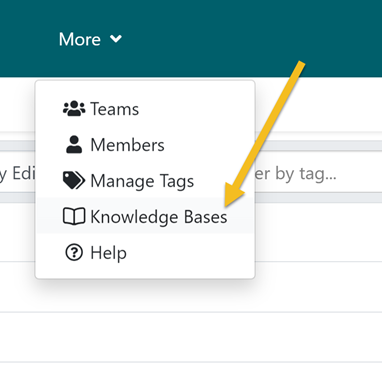
Once the new page loads up, click on the “Create Knowledge Base” button.

Type in the title of your knowledge base and then click “Continue.”

Reduce Error and Rework by Creating SOPs in SweetProcess
SweetProcess is a great tool to help you cut down on manufacturing errors and rework by creating SOPs. Forget about using spreadsheets, endless email chains, or piles of paperwork. With SweetProcess, all your manufacturing processes, procedures, and policies are in one central, accessible platform. And the sweet part? It has a mobile app that you can access from your Android or iPhone.
This tool empowers your team by giving them all the information they need to do their job well. It’s one of the easiest collaborative tools out there, uniquely suited to boost your manufacturing business. It also lets your experienced team members effortlessly share their knowledge and skills with new hires, ensuring thorough and precise process documentation. By standardizing workflows, you’ll see fewer errors and a higher quality of output.
Your dashboard becomes the central hub for creating all kinds of documents, from company processes to procedures and policies. It’s designed with an easy-to-navigate main menu that lets you access tabs for creating documents in a snap.
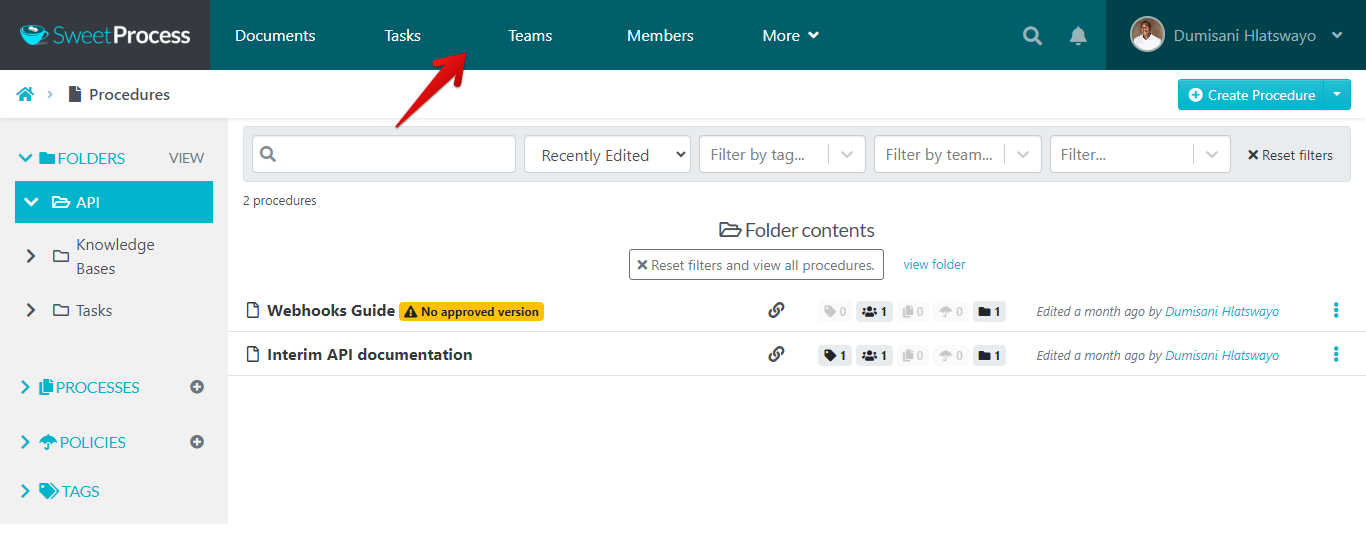
Document and Eliminate Unnecessary Steps by Creating Processes and Procedures Using SweetProcess
If you’re struggling to cut out unnecessary steps that are holding your company back from becoming lean, then SweetProcess is the right tool. Don’t believe us? Here’s a quick guide to using SweetProcess for documenting your procedures and processes.
Procedures
Creating a procedure on SweetProcess is easy and enjoyable. On the SweetProcess dashboard, just find the “Procedures” button. Click on “Create Procedure” and voilà! You can add a new procedure for your lean company.
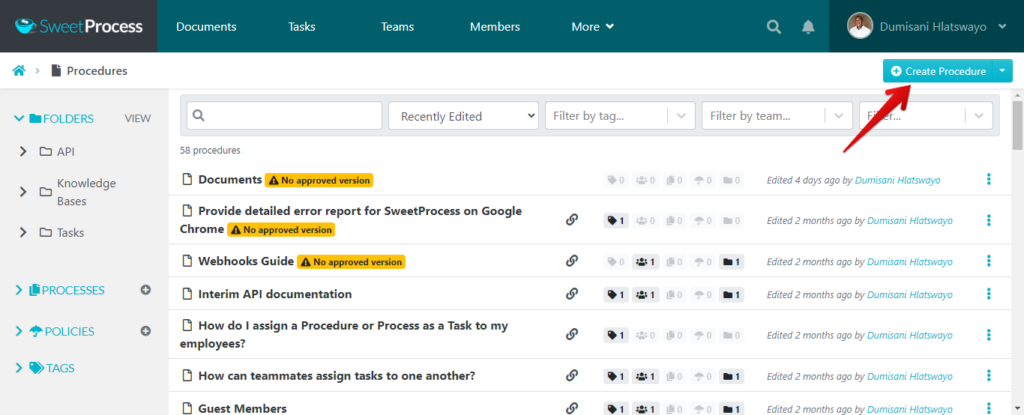
Select the “Create Procedure” option from the tabs.

Give your procedure a title that clearly describes what your lean manufacturing project is.

Click on a checkbox to add the procedure to a team and ensure it’s accessible to the right people.
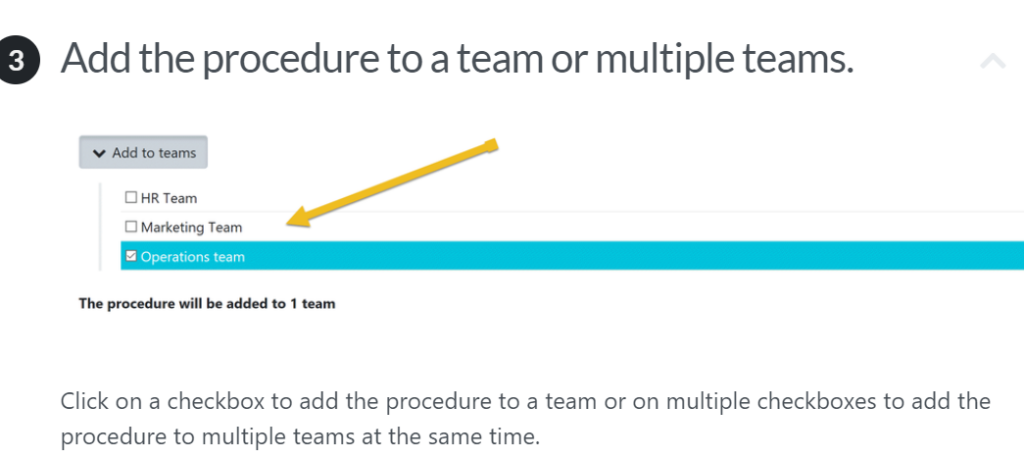
SweetProcess is pretty sweet indeed! It lets you embed procedures on external websites like WordPress, and you can also embed them on any site you like.

To embed a procedure on your website, just click the globe icon shown in the image above. If you want to make the document public, check the checkbox. Then, copy the embed code. You can use either the JavaScript embed code or, if that doesn’t work, the legacy iframe code.
Processes
Using SweetProcess to create a lean manufacturing process can help you and your team document specific tasks more efficiently, saving both time and money. To ensure clarity, consider breaking down the task into its individual components. Follow the instructions below to learn how to create a new process:
To start creating a new manufacturing process in SweetProcess, first locate the “Process” button and click on it. Once the menu opens, select the “Create Process” tab to begin outlining your new process.

Reduce Delays and Misunderstanding by Leveraging Collaboration Tools in SweetProcess
Don’t let delays and misunderstandings slow down the growth of your manufacturing business. Use SweetProcess to map out all the steps your employees should follow to complete each production task.
You can also use SweetProcess to organize and find documents with ease.
You have two options to do this. First, perform a global search on any SweetProcess page. Or you can simply press the forward-slash button on your keyboard, which serves as a shortcut.

Advantages Of Lean Manufacturing
- Cuts costs:Growing your business shouldn’t mean spending more, which is why lean manufacturing lets you make quality products at an insanely lower price. But you’ll get even more out of it if you pair lean manufacturing with an SOP software such as SweetProcess.
- Improves customer service: Lean manufacturing makes it easy for you to exceed your company’s needs.
- Produce products faster: Making your company lean this year is a smart move because it can help you produce products much faster than your competitors. When you use an SOP tool to create processes, your company is even more likely to benefit.
Disadvantages Of Lean Manufacturing
- Training costs: One downside of lean manufacturing principles is that some of them demand time for training your employees.
- Lean manufacturing principles are not 100% accurate: Before you can make your company lean, expect a few disappointments here and there. But don’t stop improving, and pray for everything to be 100% accurate. Make sure you are thorough, and let your employees know what is expected of them.
Start Your Company’s Lean Journey With SweetProcess
The journey of your company to becoming lean should start with one decision: adopting a user-friendly SOP software such as SweetProcess. Not only will SweetProcess make it easier for you to create standardized procedures and workflows that will help you reduce errors, but it will also become one of the reliable tools that you can depend on if you want to identify and eliminate waste in your manufacturing processes. This is an SOP software that will boost productivity, optimize resource allocation, and reduce downtime.
There’s no better way to document, plan, refine, and visualize every step of a workflow than by using SweetProcess. With it, you can create flowcharts that visually represent every stage of your manufacturing process. The sweet spot of using flowcharts is that they condense everything into one neat chart, making it super convenient. If there’s any task overlap, you can spot it right away.
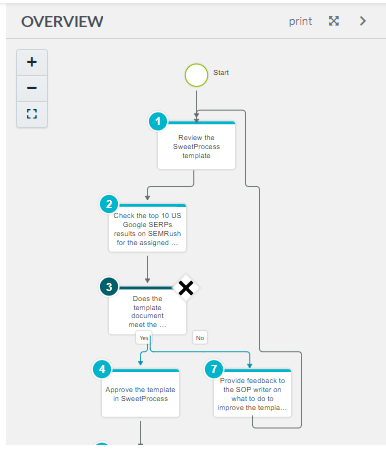
Sign up today and gain unrestricted access to all SweetProcess features without the need for any upgrades or additional payments for pro features. For only $99 per month, you and up to 20 active team members can enjoy a range of features, including:
- Creation of manufacturing procedures, policies, and processes.
- Integration with 1,000+ apps and software via Zapier.
- Monitoring and tracking of task progress.
- Importing existing procedures and policies.
- Creation of process maps and flowcharts.
- Exporting documents in different formats.
- Creating a knowledge base for employees and customers.
- Access to version history of documents.
Don’t just take our word for it. Try out SweetProcess yourself with a free trial. You don’t need a credit card, and you can cancel anytime. Click here to start for free.
